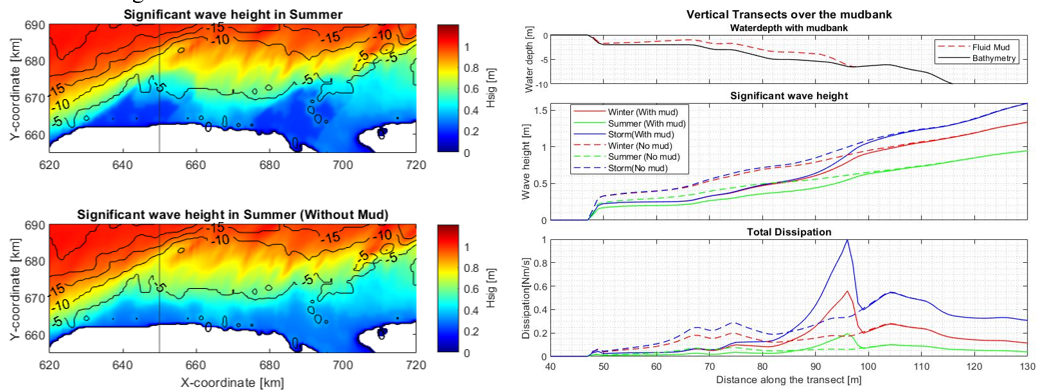Bram Loef*, Gerben Ruessink1, Bob Smits2, Steven de Jong3, Huib de Swart4
*1,3,4 Utrecht University,
2 Deltares,
Introduction
Fluid mud is suspended cohesive sediment on top of the consolidated bed. The fluid mud is generated by an external force that liquefies the bed sediment. When the water in the overlying layer is in motion, it experiences energy dissipation due to the fluid mud. In field experiments a large decrease in significant wave height was observed for beaches with fluid mud compared to beaches without this mud (Wells & Coleman, 1981). Often this fluid mud forms mudbanks in front of a shore, alternating with areas without mud, the interbank area. Different formulations for dissipation of wave energy due to fluid mud are implemented in the model SWAN-Mud, but experience with these formulations is limited. The goal of this study is to learn more about the mud-induced wave damping as a function of mud and wave characteristics . To reach this aim, various idealized model simulations were first set up in which mud and wave characteristics were varied; the model was then applied on a case study for the Suriname coast.
Methods
At the onset of this study we corrected an error in the dispersion relationships embedded in SWAN-Mud. In order to test different mud characteristics, experiments for a 1D-setting (transects) were performed, based on Kranenburg (2008). A 2D experiment with an idealized mudbank was conducted for different wave heights, periods and directions at the boundaries of the domain, as well as for different wind speeds and directions. For the Suriname experiments the same wave characteristics have been tesed. These wave and wind characteristics were based on the ERA-5 model data set, and represent summer, winter and storm conditions.
Results
After updating SWAN-Mud, results for the imaginary wavenumber (which measures the rate at which wave height exponentially decreases when wave propagate through the domain.) correspond to analytical solutions of the dispersion relationships. With the updated model we could observe the influence of the mudbanks on the incoming waves (Fig. 1). A transect taken from Fig. 1 (see Fig.2) shows that the total dissipation increases steeply at the seaward side of the mudbank during the summer, winter and storm conditions; this peak is not present when there is no mudbank. For all scenarios with mudbanks the onshore wave height is therefore considerably smaller compared to the situation without mudbanks. This is also visible in Figure 1 by the darker blue colors at the locations of the mudbanks.

Figure 1 (left): The Significant wave height at the coast of Suriname for Summer scenario. The top one includes two mudbanks, the bottom one is without mud. The transect of fig.2 is indicated with the black line. Figure 2 (right): Three different scenario's (summer, winter and a storm) are modelled for the coast of Suriname, the results of a transect over the mudbank are shown. The situations are modelled with and without mud.
Kranenburg, W. (2008). Modeling wave damping by fluid mud. M.Sc. thesis, Delft University of Technology, Netherlands.
Wells, J. T., & Coleman, J. M. (1981). Physical processes and fine-grained sediment dynamics, coast of Surinam, South America. Journal of Sedimentary Research, 51(4), 1053-1068.
I. Surname1*, F.N. Another-Surname2 , Y. Next-Surname2
1 University Name, Country; 2 Organization Name, Country
* Corresponding author: mail.name@organization.org


